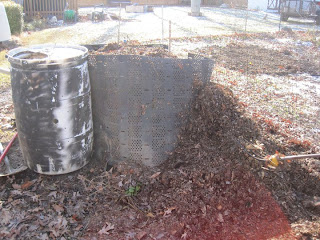This marks my first blog. I'm not talking about the first blog for "Turning Dirt To Food", but my first blog ever. I've never cared enough, or found anything worthy of writing about before this. I'm hoping that 2011 is going to a special year. I have gardened before, but this is different. There are multiple agricultural projects in the works that could be bigger and more significant than anything I have tended to in the past.
First there is the continuing project of the transformation of my small townhouse back yard into a miniature produce factory. This year will bring two more raised beds, massive containers for container gardening, (hopefully) an edible crop of two year old Spring asparagus shoots, a rain barrel collection / drip irrigation system, a small supply of blueberries, a grape vine or two, two bird families moving into the two vacant houses on the property and a bird bath, new diversity in the perennial herb garden, some strawberries from my 9 or so plants that seem to be surviving the winter, and more! Stay posted for updates, produce tallies, pictures and such.
Second there is the new compost factory, the 3 tray worm composter I am receiving courtesy of my two brothers from Christmas. It arrives tomorrow. The 500 red worms arrive next week. This coffee table sized box houses up to 2,000 worms and is said to produce a couple gallons worth of usable compost(worm castings, vermipost) each month from your kitchen scraps. The manufacturer claims there is no smell to the box, and it is perfectly OK to keep inside your house. The excess water can be used as a quick shot of liquid fertilizer for your houseplants.
Next we have the garden at my aunt's house. I struck a deal with my aunt for usage of her back yard. I cut her grass, trim her hedges, help her around the house on occasion, and she lets me use a 300 square foot fenced in parcel of her fully sunned back yard for my own agricultural desires. My open pile compost system is fully active there right now. I have at the ready 150 pounds of year-old finished compost, and three times that in organic material still breaking down. I am negotiating permission to start a small chicken coop there to house two to three hens for egg laying. I may have to up the yard work as part of the deal.
Then there is the community garden. November of 2010 meant it was time for the neighborhood home owners association meeting. I had already planned to bring up the idea of starting a community garden with individual raised beds for interested residents. No communities in Charles County (Or in Southern Maryland as a whole) have any such thing as a community garden. During the meeting, there was mention of what to do with the old volleyball courts. When it was time for open forum, I stole the show when I suggested the benefits of a community garden, and the idea hit home. A few days ago I just got word that the budget for 2011 may include planning and implementation of a community garden. I have offered my services in volunteering to help establish this project, and with the initial kickoff. It would be terrific if my services are rewarded by way of a free plot for the year.
The next proposed project is the green roof at my workplace. I have permission from my boss, who just so happens to enjoy the idea of green projects. I would have to shell out the money spent on the project, but the plants grown on top of the shop would be mine. He and I have decided that to build a full green roof would require a visit from a structural engineer to discuss the load capacity of our roof. I don't think I'm going to spend that kind of dough, so the scale of this project will be much smaller. I'm going to establish a medium sized container garden on top of the building. The containers will most likely be large Rubbermaid storage bins situated on top of pallets. The roof gets full sun from dawn till dusk, and is immune to any mammalian pests. I'm also curious about the effects of elevated gardens in reference to the usual pests which most gardeners battle throughout the year. Will hungry grubs, caterpillars, beetles, and aphids still find their way to the buffet table if the garden is on the roof?
As you readers may be able to tell, I've got my hands full this year. The wild cats and weeds and flying crawling burrowing pests may think they'll get the edge on me, but I am a persistent one and am excellent at time management. Along with the above listed projects, I am taking one college class, working full time, keeping after my newly purchased home, spending plenty of time with my wonderful girlfriend, staying fit/exercising, and keeping after my newly started web blog that you are now reading. Stay posted for updates on turning dirt to food.

































